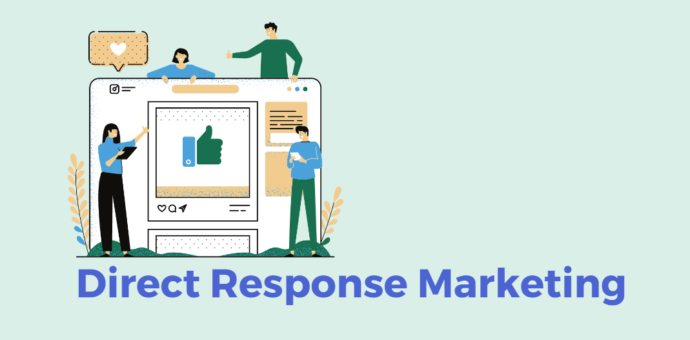Direct Response Marketing: What You Need to Know in 2023
- What is direct response marketing?
- Why should you use this digital advertising strategy?
- 4 key elements of DRM
- 10 examples of marketing campaigns
- Conclusion
Direct response marketing is used by many individuals and businesses to directly communicate and engage with their target audience.
They typically do this through personalized messages, offers, and calls to action.
In today’s highly competitive business world, when competition for customers keeps getting tougher, brands need to be smart in their marketing efforts.
To succeed, it’s essential to use marketing strategies that actually work and bring concrete outcomes.
It is such a strategy because it can quickly turn potential customers into actual buyers.
It cuts through the noise and directly encourages people to take action, making it a standout approach in the marketing arena.
Let’s move on and explore direct response marketing examples in this post.
What is direct response marketing?
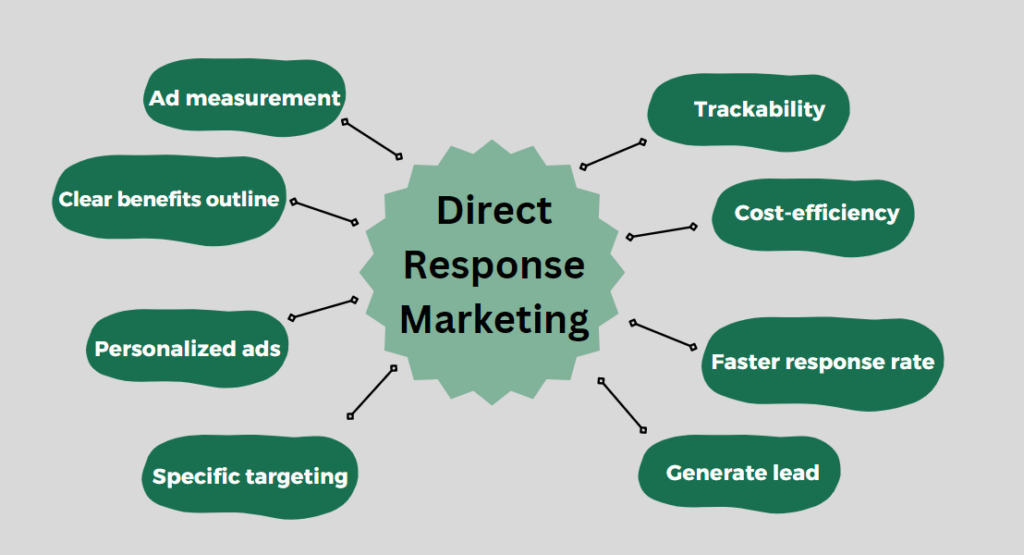
DRM is a powerful marketing strategy aimed at getting an immediate response from your target audience.
This technique is designed to prompt various actions, ranging from reading a blog post to downloading a resource or making a purchase.
The essence of direct response marketing lies in driving prompt action once prospects engage with your marketing materials.
To ensure its effectiveness, your direct response marketing campaign should skillfully combine your value proposition, pitch, and call-to-action (CTA) in a cohesive manner.
This strategic packaging facilitates the swift transition of prospects from the consideration stage to the decision stage in your buyer journey.
While many associate the marketing strategy primarily with direct mail, it encompasses a broader spectrum of channels.
Direct marketing can include:
- landing pages,
- social media advertising,
- email campaigns,
- paid advertisements,
- and even TV/radio commercials.
Essentially, it encompasses any marketing approach that necessitates an immediate response, with the primary objective of generating a quick return on investment.
Why should you use direct response marketing campaigns?
Direct response marketing tactics include:
1.) Traceable
One of the primary benefits of it is its inherent traceability.
It allows for easy monitoring and analysis of campaign performance, providing valuable insights into its effectiveness.
2.) Measurable
By breaking down the results in terms of return on investment (ROI), direct response marketing enables clear measurement of the costs incurred in reaching each customer.
Additionally, the success of the campaign can be readily measured, providing quantifiable data on its performance.
3.) Specific
Direct response marketing thrives on leveraging data to fuel targeted campaigns.
By utilizing customer information, demographics, and behavior patterns, it enables precise targeting, leading to higher conversion rates and more meaningful interactions.
Direct response marketing has a major advantage: it gets results fast. But that’s not all.
This strategy has many other benefits that make it really effective. So, it’s a smart move to use it often in your marketing efforts.
4 core elements of a direct response marketing campaign
To achieve your marketing goals, every direct response marketing campaign includes essential elements that guarantee its effectiveness.
Let’s explore the key components:
1.) Customized offer
A successful direct response marketing campaign hinges on understanding your specific target audience.
By identifying their needs, desires, and challenges, you can create a tailored offer that resonates with them.
Research reveals that 80 percent of customers are inclined to engage with brands that provide personalized experiences.
2.) Creating clear and compelling content
To ensure the effectiveness of your campaign, it is important to develop content that has the following characteristics:
✔️Clear
Use straightforward and everyday language that can be easily comprehended by anyone who reads it.
Clearly communicate the details of what you are selling, with a particular emphasis on highlighting the benefits.
Additionally, make it evident what specific action you want the reader to take in response.
✔️Compelling
Direct response marketing seeks to generate immediate customer reactions.
To achieve this, employ an active voice and incorporate powerful words that evoke the desired response.
By using persuasive language, you can effectively engage your audience and encourage them to take action promptly.
Remember, investing in skilled writers is essential for the success of your ad campaigns, as the quality of your copy significantly influences its outcomes.
3.) Need for urgency
An essential element that significantly boosts conversions is instilling a sense of urgency. It is common for people to procrastinate, especially when it comes to spending money.
By creating a sense of urgency, you encourage swift interactions and prompt decision-making. This, in turn, leads to higher conversion rates for your campaign.
4.) Crafting an Irresistible Call-to-Action (CTA)
A crucial aspect of successful direct response marketing is a compelling CTA.
Your CTA should possess the following attributes:
- Clarity and simplicity
- Accessibility
- Personalization
By incorporating these key elements into your CTA, you can effectively prompt the desired action from your customers, achieving the purpose of your direct response marketing campaign.
10 examples of direct response campaigns
Having gained an understanding of direct response ads, their benefits, and the essential elements that drive their effectiveness, let’s delve deeper and explore ten real-life examples of direct marketing campaigns.
1.) Referral Program
Word-of-mouth marketing (WOMM) holds significant power as one of the most effective forms of promotion. Research indicates that 83% of individuals trust recommendations from their family, friends, or colleagues.
Harnessing this potential, a prime illustration of successful direct response marketing lies in the implementation of a referral program.

A typical example involves launching a campaign where you invite existing customers to refer your brand or product to their network.
This can be achieved through various means, such as:
- Sending a referral program invitation via email.
- Prompting customers for referrals on the “thank you” page following their purchase.
- Facilitating ease by providing a dedicated referral link to a specific page you wish their friends to visit.
To encourage customer participation, consider offering incentives such as gifts, discounts, or tailored perks that align with your business model.
This form of direct response marketing entails immediate customer action.
Take a look at an email example from The Body Shop, which effectively employs direct response marketing to prompt customers to join their referral.
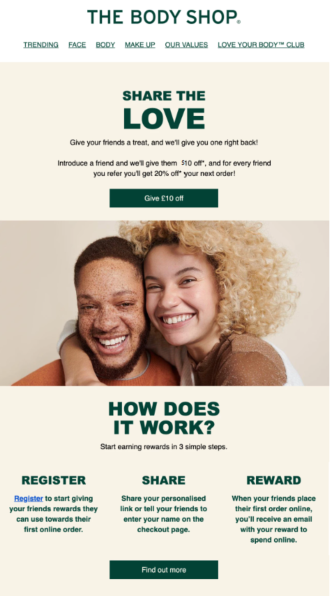
When executed successfully, referral marketing of this nature generates increased sales and enhances brand awareness simultaneously.
2.) Upselling: Maximizing Customer Value
Upselling involves persuading a customer to purchase a higher-priced version of a product they already intend to buy.
This technique holds immense power in driving sales, as it is generally easier to sell to an existing customer than to acquire a new prospect.
How can you employ direct response marketing to implement upselling strategies?
Just before a customer finalizes their purchase on your website, you can present them with a message offering the option to upgrade to a superior version of the product or service they are considering.
It is essential to clearly outline the benefits of the upgrade and provide a seamless transition process to the new product.
By utilizing direct response marketing techniques, you encourage immediate customer response and capitalize on the opportunity to enhance their experience while maximizing their value with your brand.
3.) Social media direct response ads
With a staggering global user base of approximately 4 billion individuals, social media has emerged as a formidable marketing platform for deploying direct response marketing campaigns.
Whether you are promoting a physical or digital product, a service, or seeking to generate leads, social media offers a valuable avenue to prompt immediate action from your prospects.
Direct response ads through social media allow you to capture your audience’s attention and spur them into swift action.
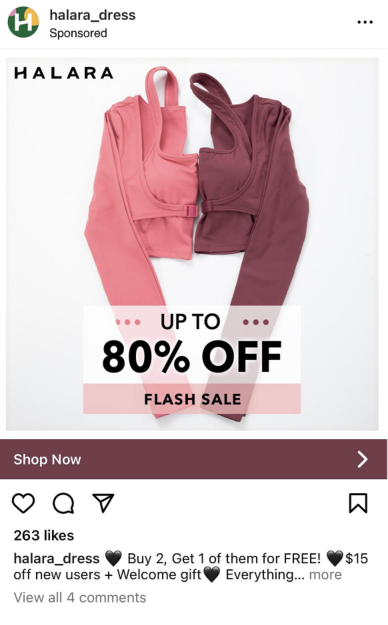
To achieve this, ensure that your ad incorporates the following elements:
- High-quality and relevant visuals
- Short, punchy copy
- Clear Call-to-Action (CTA)
By carefully designing your social media ads to grab attention through visually striking visuals and delivering persuasive copy, you can effectively drive response from your audience and increase the likelihood of conversions.
See how social media has changed marketing in our article.
4.) Giveaways or contests
Contests hold a universal appeal, captivating audiences with the allure of receiving something for free.
As a marketer, contests and giveaways present an excellent opportunity to capture attention and generate buzz.

However, the true power of giveaways lies in their ability to elicit an immediate response from your target audience, making them a valuable tool for effective direct response marketing campaigns.
When organizing contests or giveaways, it is essential to carefully select gifts or rewards that align with your brand.
By doing so, you ensure that your campaign resonates exclusively with your intended audience, maximizing its impact and relevance.
5.) Text messaging: the power of instant communication
Recent studies indicate that 77 percent of consumers prioritize texting as their preferred form of communication.
Combining this preference with the regularity with which individuals check their text messages, you have an ideal channel for executing direct response marketing strategies.
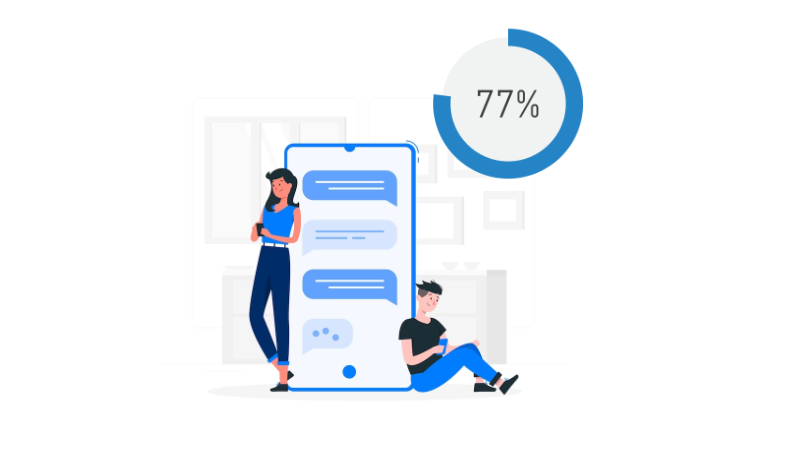
To leverage text messaging effectively in DRM, it is essential for your target audience to voluntarily sign up to receive digital marketing communication from your brand.
Similar to email marketing, segmentation of your contact list is crucial to ensure personalized and targeted campaigns.
Text messaging provides an excellent avenue to promptly notify your customers about exclusive deals and offers.
It serves as a convenient tool to redirect them to your website, as you can conveniently include a clickable link within your message.
6.) Chatbots and Social Media Messaging
Chatbots have emerged as a prominent marketing trend, thanks to their ability to facilitate real-time communication with customers.

This instant interaction capability makes chatbots a valuable asset for direct response marketing, as they effectively drive engagement and prompt immediate action.
Enter the dynamic synergy between chatbots and social media messaging.
Imagine harnessing the power of a Facebook Messenger chatbot, allowing you to interact with prospects and promote your offerings while they engage with Facebook.
This combination offers significant advantages, with social media platforms providing a wealth of data for hyper-targeting your campaigns.
By deploying a chatbot on social media, you can engage with your audience in real-time, delivering personalized marketing messages and guiding them through the customer journey.
7.) Google direct response ads
Google Ads present an exceptional avenue for promoting your brand and products, offering unparalleled reach compared to other direct response marketing channels.
With the ability to target specific audiences through strategic keyword selection, geographical targeting, and other criteria, it provides precise control over your campaign’s visibility.
The inherent advantage of Google Ads lies in their contextuality. Your ads are displayed to prospects precisely when they are actively searching for products or information related to your offerings.

This opportune timing makes it easier to capture their attention and elicit a response.
By leveraging Google Ads, you can maximize visibility, engage potential customers at the right moment, and entice them to respond to your advertisements.
The power of precise targeting combined with prime advertising real estate ensures that your efforts yield optimal results in driving conversions and attracting interested prospects.
8.) Direct response campaigns for recruiting
Direct response marketing examples extend beyond customer acquisition and sales; it can also revolutionize the process of talent recruiting.
In competitive industries where skilled professionals are scarce and speed is crucial, direct response marketing serves as a powerful tool for attracting top talent.
Recruiting agencies can also leverage this strategy to identify exceptional candidates for their clients.
SAP, a leading software company, has successfully employed direct response marketing techniques to attract top-notch talent.
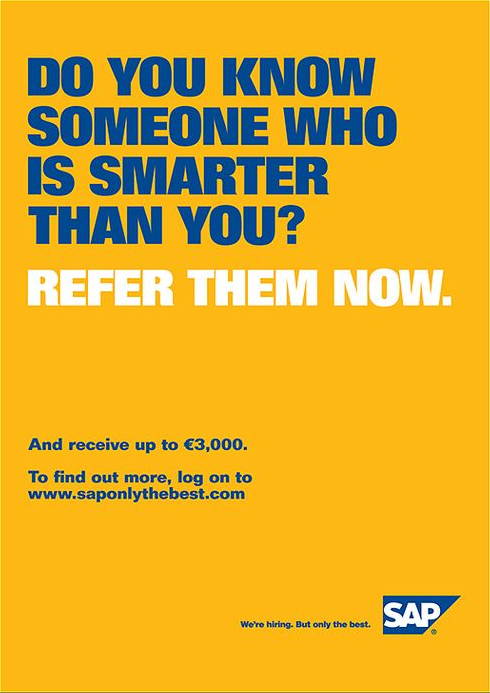
Let’s examine their approach:
- Concise and Clear Messaging: Their recruitment ad cuts to the chase, clearly stating the purpose and expectations for talented employees.
- Incentives for Action: To entice immediate response, it sweetens the deal by offering guaranteed earnings, a compelling motivator for potential workers.
This combination of direct messaging and appealing incentives effectively elicits swift responses from prospects, accelerating the talent acquisition process.
By applying direct response marketing principles to talent recruitment, businesses and agencies can efficiently attract qualified individuals who align with their requirements.
This innovative approach streamlines the hiring process and ensures that organizations secure the best-fit candidates swiftly and effectively.
9.) Generate leads quickly using pop-ups
Generating leads is a crucial aspect of marketing, and direct response advertising provides a powerful avenue for acquiring valuable leads for your business.
An effective method for lead generation is the strategic use of pop-ups on your website. When visitors land on your site, it indicates their interest in your offerings.
Seize this opportunity to establish a connection with them. Employ personalized pop-ups that entice them to join your email list and initiate a lasting relationship.
10.)Direct mail continues to yield results
Although considered traditional marketing or old-fashioned, direct mail remains a highly effective direct response ad strategy.
Since many brands have shifted away from it, leveraging direct response marketing through mail can make your campaign truly stand out.
Utilize assets such as brochures, coupons, newsletters, and more.
While direct mail may have a nostalgic touch, you can infuse it with modern techniques to amplify its impact. For instance, incorporate QR codes to seamlessly guide your prospects from the mail to your website.
Don’t dismiss direct mail. It retains its relevance today, just as it did during its prime.
Conclusion
Direct response advertising offers a powerful and targeted approach to engaging your audience and driving conversions.
By using personalized offers, compelling content, urgency, and effective calls-to-action, you can achieve rapid and measurable results.
From referral programs to social media direct response ads and direct mail, there are various successful examples of direct response marketing strategies.
Embrace this dynamic approach for a successful direct response campaign and propel your brand towards success in a competitive landscape.
To optimize your marketing more, check out our article about the best content marketing and market research tools.
